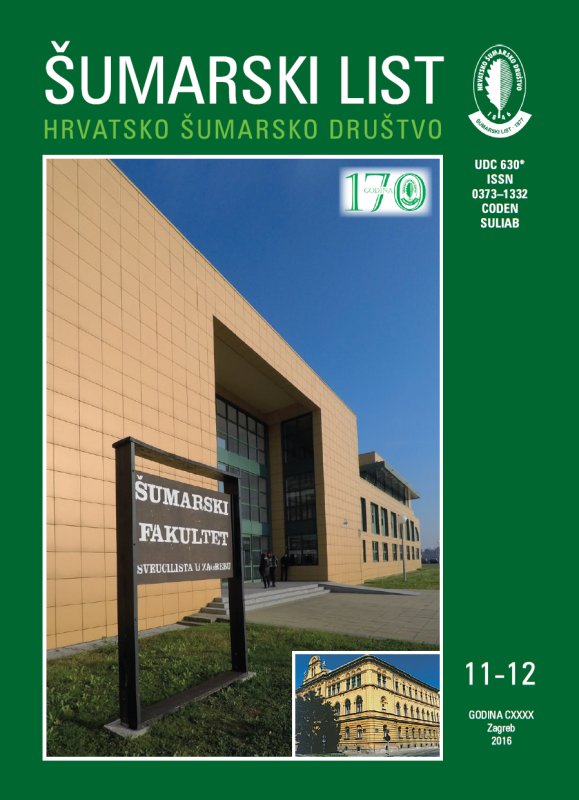
broj: 11-12/2016
pdf (16,97 MB) |
|
||||||||||||||
| RIJEČ UREDNIŠTVA | ||
| Uredništvo | ||
| THE FIRST CONFERENCE OF LICENCED FORESTRY AND WOOD TECHNOLOGY ENGINEERS pdf HR EN | 537 | |
| IZVORNI ZNANSTVENI ČLANCI | ||
| Damir DRVODELIĆ, Milan ORŠANIĆ | UDK 630* 232.3 (Fraxinus angustifolia Vahl.) (001) | |
| ASSESSMENT OF VIABILITY OF FRESH AND DELAYED GERMINATION SEEDS OF NARROW-LEAVED ASH (Fraxinus angustifolia Vahl) pdf HR EN | 539 | |
| Summary This paper compares the viability of freshly collected and delayed germination seeds of Narrow-leaved ash as one of the main tree species in lowland forests of Posavina. This tree species is of particular interest to us due to its growth rate, short rotation as compared to that of common oak, as well as the technical value of wood. The seeds of the genus Fraxinus spp. often have a pericarp, which is impermeable to oxygen, metabolic inhibitors in the endosperm and embryos, immature embryos or lack of substances that promote embryo growth. Seed dormancy is usually eliminated with warm-wet and cold-wet process. The seeds were collected in the Josip Kozarac forest management unit, managed by the forest office Lipovljani. The viabiliy of the seeds that were collected earliest (21 August) was estimated using the topographical tetrazole method in accordance with the ISTA rules. The seeds of Narrow-leaved ash (crop 2013) in the nursery Brestje was placed under stratification in the open on 16 January 2015 and sown on 21 March 2015. Stratification lasted for 64 days. The delayed germination seeds of Narrow-leaved ash were collected on 20 October 2015. Viability was assessed using the same methodology as in the case of fresh seeds. Fresh seeds have viability of 91%. There was 9% of non-viable seed, of which the largest percent have empty seeds (5%), followed by insect-damaged seeds (3%) and seeds in which the embryo and endosperm had unstained areas or necrosis. Delayed germination seeds had seed vigour of 87%. There were 13% of non-viable seeds, of which the highest percentage were the seeds containing embryos with unstained surfaces or necroses, and fully coloured endosperm (10%). Seeds in which the embryo and endosperm had unstained surfaces or necrosis accounted for 3%. Necrosis or embryo rot, which then spread to the endosperm, was detected in non-viable delayed germination seed. As for necrosis or embryo rot, seeds were observed with complete necrosis, necrosis of cotyledons, hypocotyls and plumule, hypocotyls and radicle and radicle alone. In the spring of 2015 nursery seed germination in the nursery Brestje was 0% despite 82% vitality. A statistically significant difference was found between the viability of fresh and delayed germination seeds. The viability of delayed germination seeds was 4% lower than that of fresh seeds. Based on these studies, the collection of seeds of Narrow-leaved ash is recommended to begin from the second half of August, since such seeds manifest high viability. When sowing seeds in the nursery, account should be taken of its age, pre-sowing preparation and sowing time. A recommendation for future nursery production of Narrow-leaved ash seedlings with a generative method involves determining the optimal type and duration of seed stratification with respect to micro-relief growth diversity of parent trees from which the seeds are collected (micro-depressions, unsoaked micro-depressions, micro-elevations), climate and seed zoning. Key words: seed viability; the tetrazole method; Narrow-leaved ash; ISTA rules; seed dormancy | ||
| Stefan F. WIRTH, Olivia WEIS, Milan PERNEK | UDK 630* 453 (001) | |
| COMPARISON OF PHORETIC MITES ASSOCIATED WITH BARK BEETLES Ips typographus AND Ips cembrae FROM CENTRAL CROATIA pdf HR EN | 549 | |
| Tolga OZTURK, Necmettin SENTURK | UDK 630* 376 (001) | |
| PRODUCTIVITY AND COSTS OF TIMBER EXTRACTION BY URUS MIII SKYLINE YARDER IN NORTHEAST TURKEY pdf HR EN | 561 | |
| Turan SÖNMEZ, Aydin KAHRIMAN, Abdurrahman ŞAHIN, Mehmet YAVUZ | UDK 630* 537 (001) | |
| BIOMASS EQUATIONS FOR CALABRIAN PINE IN THE MEDITERRANEAN REGION OF TURKEY pdf HR EN | 567 | |
| PREGLEDNI ČLANCI | ||
| Maja JURC, György CSÓKA, Boris HRAŠOVEC | UDK 630* 453 | |
| POTENTIALLY IMPORTANT INSECT PESTS OF Celtis australis IN SLOVENIA, CROATIA AND HUNGARY pdf HR EN | 577 | |
| Milorad DANILOVIĆ, Slavica ANTONIĆ, Zoran ĐORĐEVIĆ, Pajo VOJVODIĆ | UDK 630* 964 | |
| FORESTRY WORK-RELATED INJURIES IN FOREST ESTATE „SREMSKA MITROVICA“ IN SERBIA pdf HR EN | 589 | |


